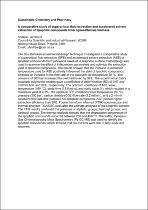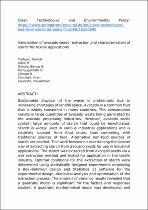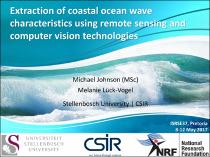 ResearchSpace
ResearchSpace
A comparative study of supercritical fluid extraction and accelerated solvent extraction of lipophilic compounds from lignocellulosic biomass
JavaScript is disabled for your browser. Some features of this site may not work without it.
- ResearchSpace
- →
- Research Publications/Outputs
- →
- Journal Articles
- →
- View Item
| dc.contributor.author |
Khanyile, AT

|
|
| dc.contributor.author |
Andrew, Jerome E

|
|
| dc.contributor.author |
Paul, V

|
|
| dc.contributor.author |
Sithole, Bishop B

|
|
| dc.date.accessioned | 2024-02-07T07:36:40Z | |
| dc.date.available | 2024-02-07T07:36:40Z | |
| dc.date.issued | 2022-05 | |
| dc.identifier.citation | Khanyile, A., Andrew, J.E., Paul, V. & Sithole, B.B. 2022. A comparative study of supercritical fluid extraction and accelerated solvent extraction of lipophilic compounds from lignocellulosic biomass. <i>Sustainable Chemistry and Pharmacy, 26.</i> http://hdl.handle.net/10204/13593 | en_ZA |
| dc.identifier.issn | 2352-5541 | |
| dc.identifier.uri | https://doi.org/10.1016/j.scp.2022.100608 | |
| dc.identifier.uri | http://hdl.handle.net/10204/13593 | |
| dc.description.abstract | The Box-Behnken experimental design technique investigated a comparative study of supercritical fluid extraction (SFE) and accelerated solvent extraction (ASE) of lipophilic compounds from pinewood sawdust. A response surface methodology was used to examine the effect of independent parameters and optimize the extraction yield of lipophilic compounds. The results showed that the increase in extraction temperature used for ASE positively influenced the yield of lipophilic compounds, whereas an increase in the flow rate of the cosolvent at temperature 50 °C, and pressure of 300 bar increased the yield achieved by SFE. The experimental data's quadratic polynomial models gave a coefficient of determination (R2) of 0.87 and 0.80 for ASE and SFE, respectively. The optimum conditions of ASE were temperature (160 °C), static time (12.5 mins), and static cycle (1), which resulted in a maximum yield of 4.2%. The optimum SFE conditions were temperature (50 °C), pressure (300 bar), carbon dioxide (CO2) flow rate (3.2 ml/min), and a 2 ml/min cosolvent flow rate that yielded 2.5% lipophilic compounds. ASE yielded higher extraction efficiency than SFE. Fourier transform infra-red (FTIR) spectroscopy and thermal analyses TGA/DSC evaluated the ultimate analyses of the lipophilic extracts. The FTIR results confirmed the presence of aliphatic groups, hydroxyl groups, and carboxyl groups. The thermal analysis showed that the degradation temperature of the lipophilic compounds occurred between 250 and 450 °C. Thereafter, Pyrolysis-Gas Chromatography Mass Spectrometry (Py-GC/MS) was used to identify the lipophilic compounds, which showed that the extracts were rich in fatty acids and terpenes. | en_US |
| dc.format | Abstract | en_US |
| dc.language.iso | en | en_US |
| dc.relation.uri | https://www.sciencedirect.com/science/article/pii/S2352554122000122 | en_US |
| dc.source | Sustainable Chemistry and Pharmacy, 26 | en_US |
| dc.subject | Pinewood sawdust | en_US |
| dc.subject | Response surface methodology | en_US |
| dc.subject | Green extraction techniques | en_US |
| dc.subject | Supercritical fluid carbon dioxide | en_US |
| dc.subject | Lipophilic extractives | en_US |
| dc.subject | Accelerated solvent extraction | en_US |
| dc.title | A comparative study of supercritical fluid extraction and accelerated solvent extraction of lipophilic compounds from lignocellulosic biomass | en_US |
| dc.type | Article | en_US |
| dc.description.pages | 26 | en_US |
| dc.description.note | © 2022 Elsevier B.V. All rights reserved. Due to copyright restrictions, the attached PDF file only contains the abstract of the full text item. For access to the full text item, please consult the publisher's website: https://doi.org/10.1016/j.scp.2022.100608 | en_US |
| dc.description.cluster | Chemicals | en_US |
| dc.description.impactarea | BT Biorefinery | en_US |
| dc.identifier.apacitation | Khanyile, A., Andrew, J. E., Paul, V., & Sithole, B. B. (2022). A comparative study of supercritical fluid extraction and accelerated solvent extraction of lipophilic compounds from lignocellulosic biomass. <i>Sustainable Chemistry and Pharmacy, 26</i>, http://hdl.handle.net/10204/13593 | en_ZA |
| dc.identifier.chicagocitation | Khanyile, AT, Jerome E Andrew, V Paul, and Bishop B Sithole "A comparative study of supercritical fluid extraction and accelerated solvent extraction of lipophilic compounds from lignocellulosic biomass." <i>Sustainable Chemistry and Pharmacy, 26</i> (2022) http://hdl.handle.net/10204/13593 | en_ZA |
| dc.identifier.vancouvercitation | Khanyile A, Andrew JE, Paul V, Sithole BB. A comparative study of supercritical fluid extraction and accelerated solvent extraction of lipophilic compounds from lignocellulosic biomass. Sustainable Chemistry and Pharmacy, 26. 2022; http://hdl.handle.net/10204/13593. | en_ZA |
| dc.identifier.ris | TY - Article AU - Khanyile, AT AU - Andrew, Jerome E AU - Paul, V AU - Sithole, Bishop B AB - The Box-Behnken experimental design technique investigated a comparative study of supercritical fluid extraction (SFE) and accelerated solvent extraction (ASE) of lipophilic compounds from pinewood sawdust. A response surface methodology was used to examine the effect of independent parameters and optimize the extraction yield of lipophilic compounds. The results showed that the increase in extraction temperature used for ASE positively influenced the yield of lipophilic compounds, whereas an increase in the flow rate of the cosolvent at temperature 50 °C, and pressure of 300 bar increased the yield achieved by SFE. The experimental data's quadratic polynomial models gave a coefficient of determination (R2) of 0.87 and 0.80 for ASE and SFE, respectively. The optimum conditions of ASE were temperature (160 °C), static time (12.5 mins), and static cycle (1), which resulted in a maximum yield of 4.2%. The optimum SFE conditions were temperature (50 °C), pressure (300 bar), carbon dioxide (CO2) flow rate (3.2 ml/min), and a 2 ml/min cosolvent flow rate that yielded 2.5% lipophilic compounds. ASE yielded higher extraction efficiency than SFE. Fourier transform infra-red (FTIR) spectroscopy and thermal analyses TGA/DSC evaluated the ultimate analyses of the lipophilic extracts. The FTIR results confirmed the presence of aliphatic groups, hydroxyl groups, and carboxyl groups. The thermal analysis showed that the degradation temperature of the lipophilic compounds occurred between 250 and 450 °C. Thereafter, Pyrolysis-Gas Chromatography Mass Spectrometry (Py-GC/MS) was used to identify the lipophilic compounds, which showed that the extracts were rich in fatty acids and terpenes. DA - 2022-05 DB - ResearchSpace DP - CSIR J1 - Sustainable Chemistry and Pharmacy, 26 KW - Pinewood sawdust KW - Response surface methodology KW - Green extraction techniques KW - Supercritical fluid carbon dioxide KW - Lipophilic extractives KW - Accelerated solvent extraction LK - https://researchspace.csir.co.za PY - 2022 SM - 2352-5541 T1 - A comparative study of supercritical fluid extraction and accelerated solvent extraction of lipophilic compounds from lignocellulosic biomass TI - A comparative study of supercritical fluid extraction and accelerated solvent extraction of lipophilic compounds from lignocellulosic biomass UR - http://hdl.handle.net/10204/13593 ER - | en_ZA |
| dc.identifier.worklist | 25905 | en_US |








